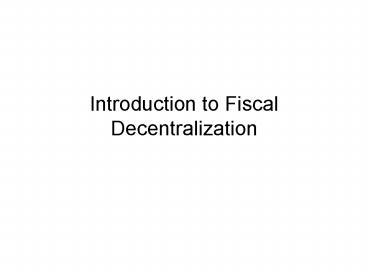Introduction to Fiscal Decentralization - PowerPoint PPT Presentation
1 / 14
Title:
Introduction to Fiscal Decentralization
Description:
Loans (short term debt) Debt Issuance (Bonds) Long Term Debt for Infrastructure. Obstacles to Fiscal Decentralization in CEE and CIS Countries ... – PowerPoint PPT presentation
Number of Views:968
Avg rating:3.0/5.0
Title: Introduction to Fiscal Decentralization
1
Introduction to Fiscal Decentralization
2
Three Economic Roles of Government
- Equitable Distribution of Income
- Stable Economic Environment
- Efficient Allocation of Resources
3
Definitions
- Fiscal Decentralization refers to an
intergovernmental system where the balance of
power moves toward the subnational government
sector - Intergovernmental Fiscal Relations refers
generally to division of fiscal powers and
responsibilities among levels of government
4
Advantages of Fiscal Decentralization
- Move Government closer to the people
- Broaden the Tax Base
- Allow for alternative service delivery in social
services
5
Components of system of fiscal decentralization
- Necessary Conditions
- Elected Local Council
- Locally Appointed Chief Officers
- Significant Local Government Revenue Capacity
- Significant Local Government Expenditure
Responsibility - Budget Autonomy
- Hard Budget Constraint
- Transparency
6
Components of System of Fiscal Decentralization
- Desirable Conditions
- Freedom from Excessive Central Expenditures
Mandates - Unconditional Transfers from Higher Level
Governments - Borrowing Powers
7
Five Building Blocks of Fiscal Decentralization
8
Structure of Government Sector
- Tiers of Government
- 2 or 3 Levels-Central,Regional, Local
- Size of Subnational Units
- Administrative-Territorial Divisions
- Boundaries of Subnational Units
- Fiscal Capacity
- Population-5,000 plus
9
Expenditure Assignments
- Functions and Services Performed by Subnational
Units - Education
- Health
- Transportation
- Social Services
- Land Use Planning
10
Revenue Assignments
- Local Taxes and Fees
- Own Source Revenues
- Shared Revenues
11
Intergovernmental Transfers
- Central to Local Levels
- General Transfers (Equalization)
- Conditional or Categorial Grants
12
Subnational Borrowing
- Loans
- (short term debt)
- Debt Issuance (Bonds)
- Long Term Debt for Infrastructure
13
Obstacles to Fiscal Decentralization in CEE and
CIS Countries
- Increase in Number of Local Units of Government
- Unfunded Mandates
- Failure to Devise Expenditure Assignment
- Too Few Tax Sources for Local Units
- Failure to Develop Credit and Borrowing System
- Financial Controls Retained by Central Level
- Lack of Intergovernmental Fiscal System based on
Transparency Rather than Negotiation and
Political Influence
14
Entry Points for UNDP
- Development of Intergovernmental Equalization
Formula - Improved Budgeting Techniques
- Program or Results Based Budgeting
- Revenue Forecasting
- Tax Administration and Collection
- Local Taxes and Fees
- Property Taxes
- Support for Financial Training
- Anti-corruption and Transparency































